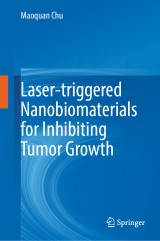Details
Laser-triggered Nanobiomaterials for Inhibiting Tumor Growth
|
CHF 177.00 |
|
| Verlag: | Springer |
| Format: | |
| Veröffentl.: | 14.09.2024 |
| ISBN/EAN: | 9789819742202 |
| Sprache: | englisch |
| Anzahl Seiten: | 250 |
Dieses eBook enthält ein Wasserzeichen.
Beschreibungen
<p>This book focuses on laser-triggered nanobiomaterials for tumor inhibition. In this book, magnetic iron oxide nanoparticle-mediated cancer PTT through intratumoral or/and intravenous injection is introduced first. The benefits of intratumoral injection and the main factors affecting the retention of materials and permeability in solid tumors have been discussed. Furthermore, an attempt has been made to explore the performance of magnetic iron oxide nanoparticles after intravenous injection for tumor-targeted PTT based on several strategies. The latter part probes the gaps to improve magnetic iron oxide nanoparticle-mediated PTT through intratumoral and intravenous injection modes. This book also includes discussion on drug-loaded magnetic nanocomposites, magnetic iron oxide/Au nanocomposites, and magnetic iron oxide/semiconductor nanocrystal nanocomposites for combination cancer therapy, and enhanced cancer PTT has also been included as an integral part. This book also summarizes the most investigated photothermal agents, including noble metal nanoparticles, especially gold nanostars, hollow mesoporous copper sulfide nanoparticles, carbon-based nanoparticles, especially carbon nanotubes and graphic carbon nanocages, black phosphorous nanosheets, conjugated polymer nanoparticles, and organic dye nanoparticles.</p>
<p>This book is useful for undergraduate and postgraduate students to better understand this research area. It may also provide useful information for technical nonspecialists whose background is in nanoscience and nanotechnology, biology, medicine, pharmacy, materials, chemistry, and physics.</p>
<p> </p>
<p>This book is useful for undergraduate and postgraduate students to better understand this research area. It may also provide useful information for technical nonspecialists whose background is in nanoscience and nanotechnology, biology, medicine, pharmacy, materials, chemistry, and physics.</p>
<p> </p>
<p>Chapter1 The photothermal conversion materials and requirements for ideal photothermal materials.- Chapter2 The advantages of magnetic iron oxide nanoparticles for cancer phothermal therapy.-Chapter3 Magnetic iron oxide nanoparticles via intratumoral injection for cancer photothermal therapy.-Chapter4 Magnetic iron oxide nanoparticles via intravenous injection for cancer photothermal therapy.-Chapter5 Laser-triggered drug-loaded magnetic iron oxide nanoparticles for cancer therapy.- Chapter6 Laser-triggered hybridize magnetic iron oxide/semiconductor nanocrystals for cancer therapy.- Chapter7 Hollow mesoporous copper sulfide nanoparticles for cancer phototherapy.- Chapter 8 Gold nanostars for cancer photothermal therapy.- Chapter 9 Laser-triggered hybridize magnetic iron oxide/gold nanoparticles for cancer therapy.- Chapter 10 Carbon nanotubes for cancer photothermal therapy.- Chapter 11 Graphic carbon nanocages for cancer photothermal therapy.- Chapter 12 Black phosphorous nanosheets for cancer photothermal therapy.- Chapter13 Organic nanoparticles for cancer photothermal therapy.</p>
<p>Professor Maoquan Chu received his PhD in Chemical Engineering from East China University of Science and Technology in 2001. He then conducted his postdoctoral work in the School of Life Science and Technology, Shanghai Jiaotong University, China. At this stage, he delved into biomaterials and nanotechnology. In 2004, he joined the School of Life Science and Technology, Tongji University, China. In 2007, he won the China Education Ministry’s “New Century Excellent Talents Supporting Plan.” In 2008, he was hired as a professor and PhD supervisor. He is now a principal investigator in the School of Life Science and Technology, Tongji University and in the Research Center for Translational Medicine, Shanghai East Hospital, China. His main area of research is nanobiomedicine, with a current focus on cancer therapy using nanobiomaterials. His recent research has been published in related journals such as <em>Biomaterials</em>,<em> Acta Biomaterialia</em>,<em> Nano Research</em>,<em> Theranostics</em>, etc. He has also published three books about biomaterials.</p>
<p> </p>
<p> </p>
<p> </p>
<p> </p>
<p> </p>
<p> </p>
<p>This book focuses on laser-triggered nanobiomaterials for tumor inhibition. In this book, magnetic iron oxide nanoparticle-mediated cancer PTT through intratumoral or/and intravenous injection is introduced first. The benefits of intratumoral injection and the main factors affecting the retention of materials and permeability in solid tumors have been discussed. Furthermore, an attempt has been made to explore the performance of magnetic iron oxide nanoparticles after intravenous injection for tumor-targeted PTT based on several strategies. The latter part probes the gaps to improve magnetic iron oxide nanoparticle-mediated PTT through intratumoral and intravenous injection modes. This book also includes discussion on drug-loaded magnetic nanocomposites, magnetic iron oxide/Au nanocomposites, and magnetic iron oxide/semiconductor nanocrystal nanocomposites for combination cancer therapy, and enhanced cancer PTT has also been included as an integral part. This book also summarizes the most investigated photothermal agents, including noble metal nanoparticles, especially gold nanostars, hollow mesoporous copper sulfide nanoparticles, carbon-based nanoparticles, especially carbon nanotubes and graphic carbon nanocages, black phosphorous nanosheets, conjugated polymer nanoparticles, and organic dye nanoparticles.</p>
<p>This book is useful for undergraduate and postgraduate students to better understand this research area. It may also provide useful information for technical nonspecialists whose background is in nanoscience and nanotechnology, biology, medicine, pharmacy, materials, chemistry, and physics.</p>
<p>This book is useful for undergraduate and postgraduate students to better understand this research area. It may also provide useful information for technical nonspecialists whose background is in nanoscience and nanotechnology, biology, medicine, pharmacy, materials, chemistry, and physics.</p>
The main factors affecting the retention of materials and permeability in solid tumors were summarized and reviewed Commonly studied photothermal materials are covered The most investigated photothermal agents at the forefront of research are included and intensively discussed


















